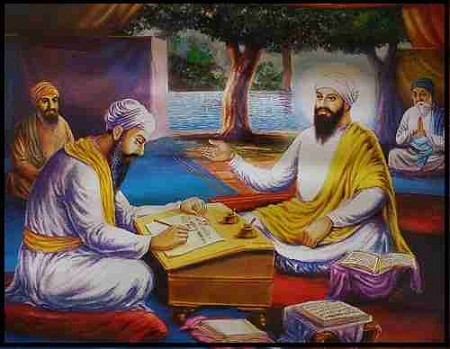- History of Guru Granth Sahib -
Guru Arjan the Fifth Sikh Guru compiled the original version of the Guru Granth Sahib. The Guru's older brother Prithi Chand as well as others had started passing off some of his own compositions as the hymns of the Gurus. Guru Arjan realized that if this situation was allowed to continue it would be the undermining of the Sikh religion. The Sikhs needed an authentic compilation of the hymns of their Gurus. Thus Guru Arjan started collection the original verses of all the Gurus. He sent trusted Sikhs such as Bhai Piara, Bhai Gurdas and Baba Buddha across the country in search of original manuscripts. Guru Arjan made trips to Goindwal, Khadur and Kartarpur to visit the families of the previous Gurus. Guru Arjan collected original manuscripts of the Gurus from Mohan (son of Guru Amar Das), Datu (son of Guru Angad) as well as Sri Chand (son of Guru Nanak).

Guru Arjan now pitched a tent by the side of Ramsar tank in Amritsar and started the arduous task of compiling the first edition of the Holy Guru Granth Sahib. Bhai Gurdas was entrusted as the Guru's scribe for the master copy. The monumental task was finally completed after a number of years. This original edition of the Guru Granth Sahib known at that time as Pothi Sahib was installed on a high pedestal within the Harmandir Sahib in August 1604. Guru Arjan seated himself at a lower level and instructed all Sikhs to bow before it, not as an idol, but as the book of divine inspiration which instructed living men in the ways of God and dedicated secular life. The revered Baba Buddha was appointed the first Granthi (custodian) of the book. Guru Arjan dictated that unlike the Hindu scriptures, the Pothi Sahib could be open to reading by anyone of any caste, creed or sex.
Guru Arjan provided the following epilogue; "Three things are there in the vessel; Truth, contentment and intellect. The ambrosial Name of God is added to it, The Name that is everybody's sustenance. He who absorbs and enjoys it shall be saved. One must not abandon this gift, It should ever remain dear to ones heart. The dark ocean of the world can be crossed by clinging to His feet. Nanak, it is He who is everywhere." (Guru Arjan Dev, Mundawani) Pothi Sahib (known today as the Kartarpur Bir) was kept by the Sixth Master Guru Hargobind in his house. From here it was stolen by his grandson Dhir Mal who intended to use it to further his claims on the succession of the Guruship. Some thirty years later the followers of the Ninth Master, Guru Tegh Bahadur forcibly recovered it, but were instructed by the Guru to return it. They placed it in the shallow river bed of the Satluj River. From here Dhir Mal recovered it, miraculously it was undamaged. Throughout the eighteenth century it most likely remained with Dhir Mal's family, the Sodhis of Kartarpur, thus the name Kartarpur Bir (Bir means volume). The Holy Book next emerged from obscurity in 1849. In that year following the annexation of Punjab, the volume together with its golden stand were discovered by the British in the custody of the Lahore royal court. An application was received from Sodhi Sadhu Singh of Kartarpur and in 1850 the volume was returned to his family. The Kartarpur Bir is preserved to this day and installed monthly for worshippers.
An unauthorized edition of the Guru Granth Sahib know as the Banno Bir also exists. Guru Arjan gave this copy of the Granth Sahib to Bhai Banno one of his disciples to take to Lahore for binding. Bhai Banno kept this volume and wrote in some verses of Sudras and Mirabai which it is believed had been rejected by the Guru as well as a few hymns allegedly to be by Guru Nanak at the end of his Granth. Guru Arjan did not approve the Banno Bir. This copy is still in the possession of the descendants of Bhai Banno.
Dhir Mal even refused to return the Kartarpur Bir over to Guru Gobind Singh, The Tenth and Final Master. While at Talwandi Sabo (known as Damdama Sahib today) Guru Gobind Singh undertook to prepare a new edition of the Granth Sahib including in it all of the hymns appearing in the original edition as well as the hymns of his late father, the Ninth Master Guru Tegh Bahadur. The Guru dictated the entire Granth to his scribe Bhai Mani Singh. Out of his humility, Guru Gobind Singh who was a great and profuse writer and poet only included one of his hymns.
The great task was finally completed in 1705. The Damdama Sahib Bir was then taken to Nanded where it was installed as desired by the Guru. Near the end of his life Guru Gobind Singh ended the line of personal Guruship by investing the Granth Sahib with the status of Eternal Guru and his official successor in 1708. Bhai Nandlal one of Guru Gobind Singhs disciples recorded the Guru's words as; "He who would wish to see the Guru, Let him come and see the Granth. He who would wish to speak to him, Let him read and reflect upon what says the Granth. He who would wish to hear his word, He should with all his heart read the Granth." (Rahitnama) In 1721 Mata Sundri the widow of Guru Gobind Singh instructed Bhai Mani Singh to go to Harmandir Sahib as the head Granthi along with the Sacred Volume. This Sacred Volume which was carried by the Sikhs before their troops on march was tragically lost in battle during the Second Sikh Holocaust - Wadda ghalughara on February 5th 1762. Fortunately since a number of copies had been made, this text has survived to today become the official authorized version of the Guru.







